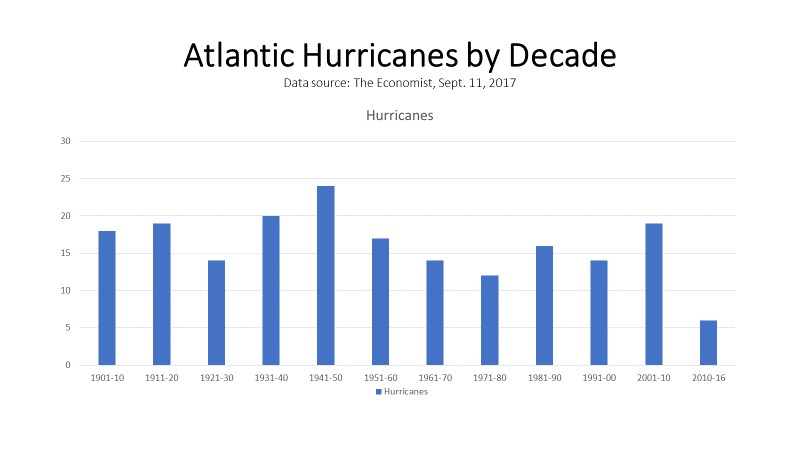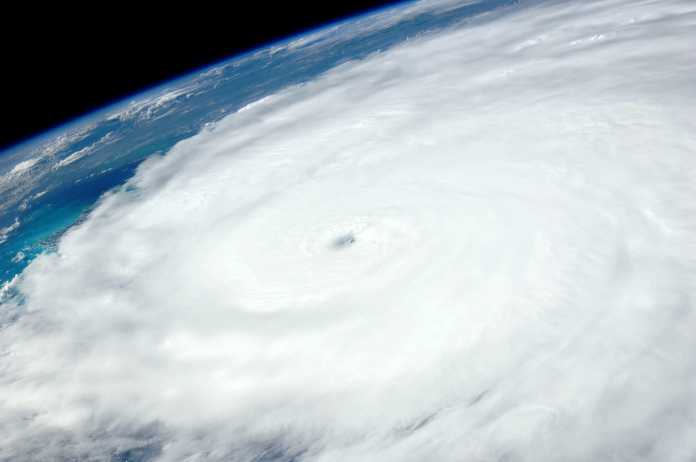Among the top Google News search results this morning for “climate change,” the Miami Herald published an article asserting a new study shows global warming is causing more Atlantic hurricanes. In reality, the new study shows there is a declining trend in hurricanes in many parts of the world and concludes there will likely be a declining trend globally during the 21st century. Moreover, objective data show the number of Atlantic hurricanes is declining, just like the forecast global trend.
The Herald article, titled “Climate change, pollution impacts hurricane formation in the Atlantic, NOAA study says,” claims, “In the last 40 years, the East Coast, including Florida, has been hit by dozens of hurricanes. New NOAA research suggests human pollution may have increased the likelihood of those Atlantic basin storms….”
The National Oceanic and Atmospheric Administration (NOAA) study referenced by the Herald reports, “our climate models project decreases in the number of global TCs [tropical cyclones] toward the end of the 21st century due to the dominant effect of greenhouse gases on decreasing TC occurrence in most of the tropics, consistent with many previous studies.”
The NOAA study reported a trend of “substantial decreases” in Indian Ocean and North Pacific hurricanes is already detected in the record. The study asserts there has been an increase in Atlantic hurricanes since 1980, which “anthropogenic aerosols could have also influenced.”
The major takeaway from the NOAA study is there will be fewer hurricanes as the world continues its modest warming. That is good news. Rather than reporting good climate news, however, the Herald goes to great lengths to try to pull some bad news from a good-news study.
Even the study’s one asserted drawback, that Atlantic hurricane activity has increased, is quite a stretch. A 2017 article in The Economist, titled “Hurricanes in America have become less frequent,” documents how Atlantic hurricanes have became much less frequent during recent decades compared to the first half of the 20th century. In the six decades between 1900 and 1960, there were an average of 19 Atlantic hurricanes each decade. In the six decades since, there has been an average of only 14 Atlantic hurricanes per decade. In fact, there has not been a single decade since 1960 in which more hurricanes formed than the average decade between 1900 and 1960.
The only reason the authors of the NOAA study could report an increase in Atlantic hurricanes since 1980 is because the decade ending in 1980 was an abnormally low year, with the fewest number of Atlantic hurricanes on record. So, any trend line starting at the record-low point of 1980 will show more frequent hurricanes. However, a more complete and representative record shows a long-term and ongoing decline in Atlantic hurricanes. The graph below illustrates that point.

Located in Florida, the Miami Herald surprisingly did not mention two very important facts about hurricanes and Florida. As documented in Climate at a Glance: Hurricanes, Florida recently concluded an 11-year period (2005 through 2016) without a landfalling hurricane of any size—the longest such period in recorded history. The Gulf of Mexico also recently benefited from its longest hurricane-free period in recorded history (2013 through 2016).
For completely misleading its readers about the recent NOAA study, and for asserting the exact opposite of the truth regarding hurricane frequency and Atlantic hurricane frequency, the Miami Herald earns a gigantic Pinocchio award.

















Is the severity of hurricanes increasing? (Velocity, humidity, etc).
No
Hello, EM. The answer is “no.”
This is a good question. And an answer is available. For the United States, the Atlantic and Gulf of Mexico, hurricanes arise from winds crossing the Sahara, and then going across the Atlantic and taking up humidity, and by a few other factors sometimes becoming hurricanes. This major phenomenon is the “Atlantic Hurricane Season.”
NOAA has made an index of the severity of a year’s hurricane season: the “Accumulated Cyclonic Energy.” To get this, you take each hurricane and note what level of storm it is at, and for how many days. And, you simply sum them. So, a hurricane that is Cat 1 for a day, Cat 2 for two days, and then Cat 1 for a day, before dying out, would get scored as 6 ACE points. If another hurricane comes along the next week and is Cat1 for two days, Cat 2 for one day, then Cat 1 day, end then dies out, it is scored at ACE of 5.
Sum all of these for the entire season and you get a measure of “severity of hurricanes.”
Wikipedia has an entry for “ACE.” It includes the ACE measures for Atlantic Hurricane seasons going back a century or so.
If you look at the trend of ACE across time, it is trending down, although the trend is not statistically different from zero.
There is one aspct of hurricanes that, statistically, may be getting worse, getting to “greater severity:” this is how slow the hurricane moves. The impact of a hurricane is worse if it moves slowly over an area. This one of several dimensions of hurricane power may be getting worse. The trend is recent and so is not quite long-lasting enough to say if it is stable.
This slow-speed aspect is not predicted anywhere as a consequence of global warming; it has emerged recently.
Thanks for an informing response to my question. Damned climate alarmists.